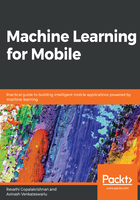
Summary
In this chapter, we were introduced to machine learning, including the types of machine learning, where they are used, and practical scenarios where they can be used. We also saw what a well-defined machine learning problem is and also understood when we need to go for a machine learning solution. Then we saw the machine learning process and the steps involved in building the machine learning model, from defining the problem of deploying the model to the field. We saw certain important terms used in the machine learning namespace that are good to know.
We saw the challenges in implementing machine learning and, specifically, we saw the need for implementing the machine learning in mobiles and the challenges surrounding this. We saw different design approaches for implementing machine learning on mobile applications. We also saw the benefits of using each of the design approaches and also noted the important considerations that we need to analyze and keep in mind when we decide to use each of the solution approaches for implementing machine learning on mobile devices. Lastly, we glanced through the important mobile machine learning SDKs that we are going to go through in detail in subsequent chapters. These include TensorFlow lite, Core ML, Fritz, ML Kit, and lastly, the cloud-based Google Vision.
In the next chapter, we will learn more about Supervised and Unsupervised machine learning and how to implement it for mobiles.